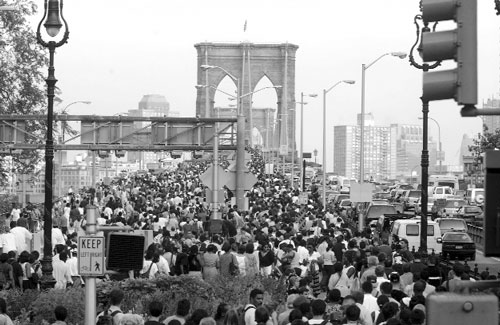By Elizabeth O’Brien
The power might have cascaded to a halt last Thursday afternoon, but the realization of what actually happened came to most New Yorkers in a trickle.
When lights and computer screens went dark at 4:11 p.m., many thought that only their floor, or their building, was affected. Then, in curbside chats or bursts from battery-powered radios, people became aware that it was bigger than their building, bigger than their block.
All five boroughs are out? Then — What’s this about Detroit? Canada??
New Yorkers hit the streets well before the cause of the blackout became clear. Many Downtown workers began a long trudge north, while Lower Manhattan became a funnel for those streaming across the Brooklyn and Manhattan bridges.
“My first thought was that it’s better to be outside than inside, and I’m not wrong,” said a man who identified himself only as Sergei, 34, who works in the Citigroup building on Greenwich St.
On their way Uptown, Sergei and a colleague had stopped to sip Belgian beers at Walker’s, on the corner of Varick and N. Moore Sts. Happy hour crowds formed early on Thursday, as people all over the city satisfied their thirst and their need for companionship — and helped drain inventory that would have gone warm.
Some managed humor amid the uncertainty.
“Are the horses still working?” Joel Sosinsky asked a police officer as he passed by the stables at the First Precinct on Varick St.
People asked the officers what was going on, but the Finest could only point the way to the bridges. You probably know more than we do, they said. In the media capital of the world, people relied on a Depression-era form of communication. Groups gathered around parked cars with the radios blaring.
Others felt too anxious to pause on their way home. The prospect of another terror attack loomed large in those first few hours.
“I don’t know what this is, but it seems like Al Qaeda,” said Monica Giraldez, 33, as she hurried out of Tribeca on her way to Grand Central. The weather also reminded her of Sept. 11, 2001: hot and sunny.
Giraldez was hoping to catch a diesel-powered train to Westchester. Home seemed a remote destination for many last Thursday afternoon.
Dana Wade, 37, and her friend Anita Adams, 36, perched on the giant picnic tables outside City Hall as they watched the crowds jockeying their way onto the Brooklyn Bridge. Both needed to go deep into Brooklyn, Wade to Sheepshead Bay and Adams to Flatbush. But neither was sure she wanted to risk passage just yet.
“To me, that just looks like a hazard,” Adams said. What if you get stuck up there and something happens? Adams wondered aloud.
It looked like a sluggish marathon on the Brooklyn Bridge, with thousands of sweaty pedestrians making their way around stopped cars. The bridge shook under the weight, and there were pockets of muted panic as walkers realized the road was bucking beneath them. A man sat down. A woman began singing a hymn.
Then came voices of reassurance.
“We’re all right,” said one woman. “It could be a lot worse.”
And then the man who spoke for us all:
“Tell me this is not a day to remember.”

































